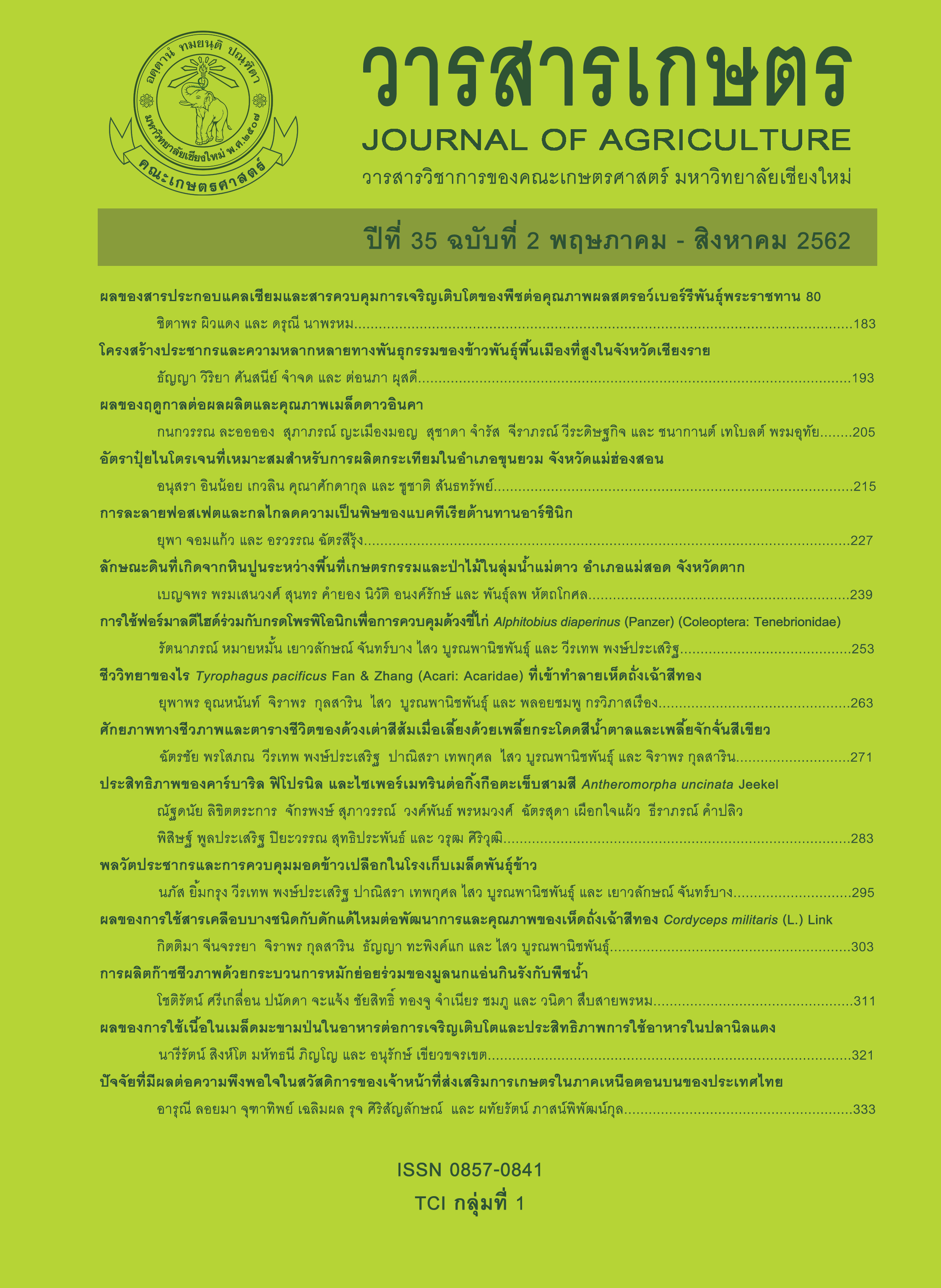ผลของการใช้เนื้อในเมล็ดมะขามป่นในอาหารต่อการเจริญเติบโตและประสิทธิภาพการใช้อาหารในปลานิลแดง
Main Article Content
บทคัดย่อ
งานวิจัยนี้ศึกษาการใช้เมล็ดมะขามซึ่งเป็นวัตถุดิบพลอยได้จากโรงงานอุตสาหกรรมแปรรูปผลิตภัณฑ์จากมะขาม เพื่อทดแทนข้าวโพดป่นในอาหารปลานิลแดงที่มีต่ออัตราการเจริญเติบโต ประสิทธิภาพการใช้อาหาร และสารอาหาร โดยใช้เมล็ดมะขามป่น 6 ระดับ คือ 0, 20, 40, 60, 80 และ 100 เปอร์เซ็นต์ ปลานิลแดงมีน้ำหนักเฉลี่ยเริ่มต้น 4.55 ± 0.02 กรัม/ตัว ใช้ระยะเวลาเลี้ยง 10 สัปดาห์ จากการทดลองพบว่าอาหารผสมเมล็ดมะขามที่ระดับ 100 เปอร์เซ็นต์ มีอัตราการเจริญเติบโต เปอร์เซ็นต์น้ำหนักที่เพิ่มขึ้น อัตราการเจริญเติบโตจำเพาะ อัตราการกินอาหาร ประสิทธิภาพการใช้อาหาร อัตราการเปลี่ยนอาหารเป็นเนื้อ ประสิทธิภาพการใช้โปรตีน โปรตีนที่นำไปใช้ประโยชน์ การเก็บรักษาโปรตีนดีที่สุด โดยไม่แตกต่างกับระดับ 80 และ 90 เปอร์เซ็นต์ เช่นเดียวกับดัชนีตับพบว่าไม่มีความแตกต่างกันทางสถิติในทุกชุดการทดลอง สำหรับดัชนีอวัยวะภายในพบว่ามีแนวโน้มลดลงเมื่อมะขามป่นสูงขึ้น ค่าประสิทธิภาพการใช้อาหาร ประสิทธิภาพการใช้โปรตีน และไขมัน มีแนวโน้มที่เพิ่มขึ้น โดยโปรตีนที่นำไปใช้ประโยชน์ พบว่าปลานิลแดงที่ได้รับอาหารที่มีส่วนผสมของเมล็ดมะขามป่นมีการนำโปรตีนไปใช้ได้ดีกว่าชุดการทดลองควบคุม ส่วนการเก็บรักษาโปรตีนไม่มีความแตกต่างกันทางสถิติ (P<0.05) การทดลองนี้แสดงให้เห็นว่าเนื้อในเมล็ดมะขามสามารถทดแทนข้าวโพดป่นได้ 100 เปอร์เซ็นต์ เป็นวัตถุดิบที่มีความเหมาะสมสำหรับสัตว์น้ำ และสามารถลดต้นทุนการผลิตสัตว์น้ำให้มีราคาต่ำลงได้
Article Details
เอกสารอ้างอิง
นฤมล อัศวเกศมณี. 2557. โภชนศาสตร์และการให้อาหารปลา. โอเดียนสโตร์, กรุงเทพฯ. 206 หน้า.
พรทิศา ทองสนิทกาญจน์ ธนภัทร วรปัสสุ และ ณัฐรินทร์ ศิริรัตนนันท์. 2560. การเสริมเมล็ดมะขามในอาหารปลานิล. รายงานการประชุมสัมมนาทางวิชาการ มหาวิทยาลัยเทคโนโลยีราชมงคลตะวันออก ครั้งที่ 10 วันที่ 29-31 พฤษภาคม 2560. พัทยา ชลบุรี.
อนุรักษ์ เขียวขจรเขต. 2561. ผลของเศษปลาหมักต่อการเจริญเติบโต ประสิทธิภาพการใช้อาหารและสารอาหารของปลานิลแดง (Oreochromis niloticus x O. mossambicus). วารสารเกษตร 34(2): 287-296.
Achi, O.K. 2005. Traditional fermented protein condiments in Nigeria. African Journal of Biotechnology 4(13): 1612-1621.
Adesola, A.A., C.L.W. Jones and T.A. Shipton. 2017. Dietary lysine requirement of juvenile dusky kob, Argyrosomus japonicus. Aquaculture Nutrition 24: 674-680.
Anand, P. and P.A. Gruppuso. 2006. Rapamycin inhibits liver growth during refeeding in rats via control of ribosomal protein translation but not cap-dependent translation initiation. Journal of Nutrition 136: 27-33.
Anthony, J.C., T.G. Anthony, S.R. Kimball, T.C. Vary and L.S. Jefferson. 2000. Orally administered leucine stimulates protein synthesis inskeletal muscle of postabsorptive rats in association with increased eIF4F formation. Journal of Nutrition 130: 139-145.
AOAC (Association of Official Analytical Chemists). 1990. Official Methods of Analysis. AOAC, Washington, D.C.
Bashir, A.Y. and B. Suleiman. 2018. Growth and feed utilization value of fermented Tamarindus indica L. seed in the diet of Oreochromis niloticus (Linnaeus, 1758). Turkish Journal of Fisheries and Aquatic Sceinces 18: 905-911.
Bhadoriya, S.S., A. Ganeshpurkar, J. Narwaria, G. Rai and A.P. Jain. 2011. Tamarindus indica: extent of explored potential. Pharmacognosy Review 5(9): 73-81.
Boonyaratpalin, M., P. Suraneiranat and T. Tunpibal. 1998. Replacement of fish meal with various types of soybean products in diets for the Asian seabass, Lates calcarifer. Aquaculture 161: 67-78.
Furuya, W.M., T.S. Graciano, L.V.O. Vidal, T.O. Xavier, L.D. Gongora, J.S. Righetti and V.R.B. Furuya. 2012. Digestible lysine requirement of Nile tilapia fingerlings fed arginine-to-lysine-balanced diets. Revista Brasileira de Zootecnia 41: 485-490.
Hauler, R.C. and C.G. Carter. 2001. Reevaluation of the quantitative dietary lysine requirements of fish. Reviews in Fisheries Science 9: 133-163.
Kerr, B.J. and R.A. Easter. 1995. Effect of feeding reduced protein, amino acid-supplemented diets on nitrogen and energy balance in grower pigs. Journal of Animal Science 73: 3000-3008.
Lansard, M., S. Panserat, E. Plagnes-Juan, K. Dias, I. Seiliez and S. Skiba-Cassy. 2011. L-leucine, L-methionine, and L-lysine are involved in the regulation of intermediary metabolism-related gene expression in rainbow trout hepatocytes. Journal of Nutrition 141: 75-80.
Makanjuola, and O. Moses. 2011. Amino acid profile of powdered fermented maize meal (Ogi) fortified with powderd unfermented locust bean seeds (Pakia biglobosa).Journal of Environmental Science, Toxicology and Food Technology 11: 28-32.
Marcouli, P. A., M.N. Alexis, A. Andriopoulou and J. Iliopoulou-Georgudak. 2006. Dietary lysine requirement of juvenile gilthead seabream, Sparus aurata L. Aquaculture Nutrition 12: 25-33.
Miao, L.P, C. Yuan, X.Y. Dong, X.Y. Zhang, M.Y. Zhou and X.T. Zou. 2017. Effects of dietary L-arginine levels on small intestine protein turnover and the expression of genes related to protein synthesis and proteolysis of layers. Poultry Science 96: 1800-1808.
Naves, M.M.V., M.V.L.de Castro, A.L. de Mendonca, G.G. Santos and M.S. Silva. 2011. Corn germ with pericarp in relation to whole corn: nutrient contents, food and protein efficiency, and protein digestibility-corrected amino acid score. Food Science and Technology 31: 264-269.
Nguta, J.M. and J.M. Mbaria. 2013. Brine shrimp toxicity and antimalarial activity of some plants traditionally used in treatment of malaria in Msambweni district of Kenya. Journal of Ethnopharmacology 148: 988-992.
NRC (National Research Council) 2011. Nutrient Requirements of Fish and Shrimp.The National Academies Press, Washington, D.C.
Ochokwu I.J., L.U. Onyia and K.O. Ajijola. 2014. Effect of Azanza garckeana (Goron Tula) pulp meal inclusion on growth performance of Clarias gariepinus Broodstock (Burchell, 1822). Nigeria Journal of Tropical Agriculture 14: 134-146.
Ren, M., Habte-Tsion, H.-M.,B. Liu, L., Miao, X. Ge, J. Xie, H. Liang, Q. Zhou and L. Pan. 2015. Dietary leucine level affects growth performance, whole body composition, plasma parameters and relative expression of TOR and TNF- in juvenile blunt snout bream, Megalobrama amblycephala. Aquaculture 448: 162-168.
Romarheim, O.H., M.A. Aslaksen, T. Storebakken, A. Krogdahl and A. Skrede. 2005. Effect of extrusion on trypsin inhibitor activity and nutrient digestibility of diets based on fish meal, soybean meal and white flakes. Archives of Animal Nutrition 59: 365-375.
Sole, S.S., B.P. Srinivasan and A.S. Akarte. 2013. Anti-inflammatory action of tamarind seeds reduces hyperglycemic excursion by repressing pancreatic ß-cell damage and normalizing SREBP-1c concentration. Pharmaceutical Biology 51: 350-360.
Vargas-Olvera, C.Y., D.J. Sanchez-Gonzalez, J.D. Solano, F.A. Aguilar-Alonso, F. Montalvo-Munoz, C.M. Martinez-Martinez, O.N. Medina-Campos and M.E. Ibarra-Rubio. 2012. Characterization of N-diethylnitrosamine-initiated and ferric nitrilotriacetate-promoted renal cell carcinoma experimental model and effect of a tamarind seed extract against acute nephrotoxicity and carcinogenesis. Molecular and Cellular Biochemistry 369: 105-117.
Zou, T., S.P. Cao, W.J. Xu, D. Han, H.K. Liu, Y.X. Yang, J.Y. Jin, X.M. Zhu and S.Q. Xie. 2018. Effects of dietary leucine levels on growth, tissue protein content and relative expression of genes related to protein synthesis in juvenile gibel carp (Carassius auratus gibelio var. CAS III). Aquaculture Research 49: 2240-2248.


